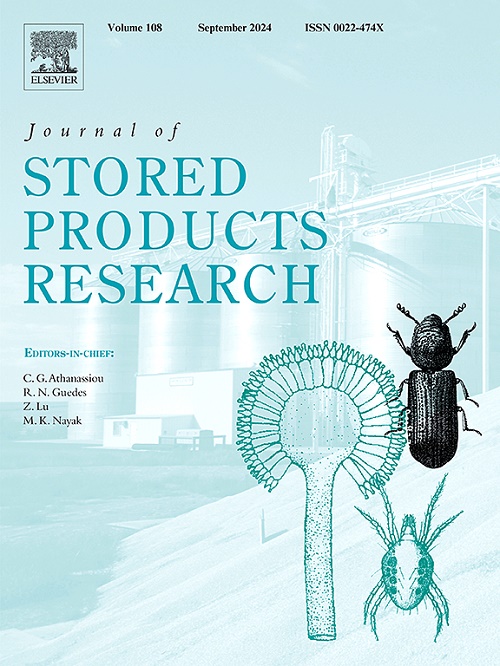Impact of feed type, environmental conditions, and pesticide usage on the growth and aflatoxin production by Aspergillus parasiticus during feed storage
IF 2.7
2区 农林科学
Q1 ENTOMOLOGY
引用次数: 0
Abstract
The co-occurrence of AFB1, AFB2, AFG1, and AFG2 in mold-contaminated feed suggests a significant contribution of A. parasiticus to aflatoxin contamination in feed. In contrast to A. flavus, research on the effects of A. parasiticus growth and aflatoxin production is limited. This study aims to investigate the factors influencing the growth and aflatoxin production by A. parasiticus, as well as to analyze the interactions among these factors utilizing response surface methodology. The results will be compared with relevant studies on A. flavus, ultimately contributing to the development of a comprehensive strategy for the prevention of aflatoxin contamination. The findings indicated that both A. parasiticus and A. flavus used sugar as an initial substrate to produce aflatoxins. The substrate preference of A. parasiticus was not changed due to differences in nutrient content in different feeds. The mineral Mn was found to suppress aflatoxin production by both fungi, whereas glucose, sucrose, and Zn stimulated production. Temperature and water activity levels effective against A. flavus may not be equally effective for A. parasiticus. The optimum storage conditions were for temperature and water activity below 10 °C and 0.85 at the same time. Although chemical pesticides may comply with regulatory limits in feed, certain pesticides and their interactions could increase the risk of aflatoxin contamination during feed storage. Hence, a comprehensive evaluation of factors influencing both fungi is imperative to prevent aflatoxin contamination effectively.
饲料类型、环境条件和农药用量对饲料贮存期间寄生曲霉生长和产生黄曲霉毒素的影响
AFB1、AFB2、AFG1和AFG2在霉菌污染的饲料中同时出现,表明寄生在饲料中对黄曲霉毒素污染有重要贡献。相对于黄曲霉而言,对寄生蜂生长和黄曲霉毒素产生影响的研究较少。本研究旨在探讨影响寄生蜂生长和黄曲霉毒素产生的因素,并利用响应面法分析各因素之间的相互作用。这些结果将与黄曲霉的相关研究进行比较,最终为黄曲霉毒素污染预防的综合策略的制定做出贡献。结果表明,寄生蜂和黄曲霉均以糖为初始底物产生黄曲霉毒素。不同饲料中营养成分的差异不影响寄生蜂对基质的偏好。矿物质锰抑制两种真菌产生黄曲霉毒素,而葡萄糖、蔗糖和锌则促进黄曲霉毒素的产生。温度和水的活性水平对黄曲单孢霉有效,但对寄生单孢霉未必同样有效。最佳贮藏条件为温度和水活度分别低于10℃和0.85。虽然饲料中的化学农药可能符合监管限制,但某些农药及其相互作用可能会增加饲料储存过程中黄曲霉毒素污染的风险。因此,综合评价影响这两种真菌的因素是有效预防黄曲霉毒素污染的必要条件。
本文章由计算机程序翻译,如有差异,请以英文原文为准。
求助全文
约1分钟内获得全文
求助全文
来源期刊
CiteScore
5.70
自引率
18.50%
发文量
112
审稿时长
45 days
期刊介绍:
The Journal of Stored Products Research provides an international medium for the publication of both reviews and original results from laboratory and field studies on the preservation and safety of stored products, notably food stocks, covering storage-related problems from the producer through the supply chain to the consumer. Stored products are characterised by having relatively low moisture content and include raw and semi-processed foods, animal feedstuffs, and a range of other durable items, including materials such as clothing or museum artefacts.

 求助内容:
求助内容: 应助结果提醒方式:
应助结果提醒方式:


